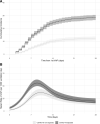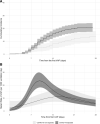Increased Incidence of Ventilator-Acquired Pneumonia in Coronavirus Disease 2019 Patients: A Multicentric Cohort Study
- PMID: 34637422
- PMCID: PMC8855761
- DOI: 10.1097/CCM.0000000000005297
Increased Incidence of Ventilator-Acquired Pneumonia in Coronavirus Disease 2019 Patients: A Multicentric Cohort Study
Abstract
Objectives: Little is known about the epidemiology of ventilator-acquired pneumonia among coronavirus disease 2019 patients such as incidence or etiological agents. Some studies suggest a higher risk of ventilator-associated pneumonia in this specific population.
Design: Cohort exposed/nonexposed study among the REA-REZO surveillance network.
Setting: Multicentric; ICUs in France.
Patients: The coronavirus disease 2019 patients at admission were matched on the age, sex, center of inclusion, presence of antimicrobial therapy at admission, patient provenance, time from ICU admission to mechanical ventilation, and Simplified Acute Physiology Score II at admission to the patients included between 2016 and 2019 within the same surveillance network (1:1).
Interventions: None.
Measurements and main results: The overall incidence of ventilator-associated pneumonia, the cumulative incidence, and hazard rate of the first and the second ventilator-associated pneumonia were estimated. In addition, the ventilator-associated pneumonia microbiological ecology and specific resistant pattern in coronavirus disease 2019 exposed and nonexposed patients were compared. Medication data were not collected. A total of 1,879 patients were included in each group. The overall incidence of ventilator-associated pneumonia was higher among coronavirus disease 2019 exposed patients (25.5; 95% CI [23.7-27.45] vs 15.4; 95% CI [13.7-17.3] ventilator-associated pneumonia per 1,000 ventilation days). The cumulative incidence was higher for the first and the second ventilator-associated pneumonia among the coronavirus disease 2019 exposed patients (respective Gray test p < 0.0001 and 0.0167). The microbiological ecology and resistance were comparable between groups with a predominance of Enterobacterales and nonfermenting Gram-negative bacteria. The documented resistance pattern was similar between groups, except for a lower rate of methicillin-resistant Staphylococcus aureus in the coronavirus disease 2019 exposed patient (6% vs 23%; p = 0.013).
Conclusions: There was a higher incidence of ventilator-associated pneumonia occurring among coronavirus disease 2019 patient compared with the general ICU population, with a similar microbiological ecology and resistance pattern.
Copyright © 2021 by the Society of Critical Care Medicine and Wolters Kluwer Health, Inc. All Rights Reserved.
Conflict of interest statement
Dr. Vanhems’ institution received funding from Anios; he received funding from Astellas and Sanofi. Drs. Vanhem and Friggeri received funding from Pfizer. Dr. Friggeri received funding from MSD. The remaining authors have disclosed that they do not have any potential conflicts of interest.
Figures



Comment in
-
Is Ventilator-Associated Pneumonia More Frequent in Patients With Coronavirus Disease 2019?Crit Care Med. 2022 Mar 1;50(3):522-524. doi: 10.1097/CCM.0000000000005389. Crit Care Med. 2022. PMID: 34799489 Free PMC article. No abstract available.
References
Publication types
MeSH terms
LinkOut - more resources
Full Text Sources
Medical

